Somalia 20 Years Later – Lessons Learned, Re-learned and Forgotten
Michael A. Marra and William G. Pierce
SWJ Editor’s Note: As we near the 20- year anniversary of the Battle of Mogadishu, it is worthwhile to look back at U.S. and U.N. involvement in that effort to see what we have learned and can learn as we debate current narratives for military involvement in contemporary hotspots. Somalia was the beginning of a new paradigm, where predominantly combat forces from the U.S. and other nations were tasked to conduct humanitarian assistance and peacekeeping operations in environments of complex-catastrophe.
"Me against my brother,
My brother and I against our family,
Our family against our tribe,
Our tribe against other tribes,
All the tribes against Somalia,
And Somalia and Somalis against the world"
-Somali Proverb
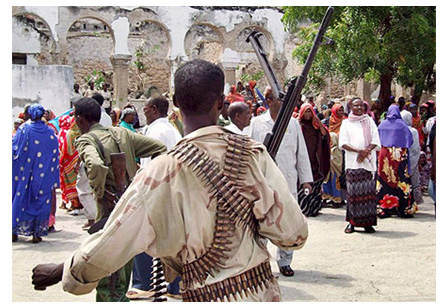
Twenty years ago on 3 October, 1993, a desperate battle took place on the streets and in the air of the coastal city of Mogadishu, Somalia between American Soldiers and irregular militia from Clan of Mohamed Farrah Aideed from the Somali National Alliance (SNA). The battle, fought mostly within and above a single square mile of dense urban sprawl, would rage for nearly the entire day.
That fateful day would end with 17 Americans killed in action - two of which earned posthumous Medals of Honor, another 85 wounded some grievously, and an estimated 1,500 Somali casualties either killed, wounded captured or missing.[1] The battle epitomized the desperate struggle of modern urban warfare in tribal terrain - negating many of the advantages that technology usually offers the better equipped force, and drove small groups of fighters on both sides into desperate hand-to-hand combat that U.S. troops had not experienced in several decades. This was a tactical engagement to be sure, but the strategic implications of this comparatively minor battle reverberated around the world and are still evident in our psyche and policies today, 20 years later.
Like so many epic battles though history, this was a tactical event with strategic effects due to the advent of “instant access” via the new 24/7 news broadcasts. In 1993, at the leading edge of the Information Age, the era of the video camera on the battlefield had come to full- maturity and the means to capture moving battlefield images and project them worldwide through new, never-ending "24/7" news media had permanently arrived. The Persian Gulf War of 1991 had raised the standard of information-sharing, and now Mogadishu became the event de jure for audiences conditioned for constant stimulation from wartime venues. The entire world was captivated by horrific scenes of dead United States soldiers being dragged through the streets of Mogadishu by cheering , wild Somali mobs around them, seemingly celebrating the battle - as if killing any U.S. Soldier constituted victory.
In fact, the special operations mission that day had technically succeeded. The U.S. led force captured twenty four key planners and operators in the Somali National Alliance (SNA) and inflicted significant damage on Aideed's forces. Unfortunately, the military success was a Pyrrhic Victory, and world opinion viewed this operation as a clear U.S. failure - not just in the battle, but ostensibly for the entire effort in Somalia.
Worldwide audiences did not concern themselves with the tactical military implications of the battle and who was captured or even to the damage suffered by the Somali irregulars. The prevailing narrative only focused on the Americans, fresh off of an overwhelming victory in the 1991 Persian Gulf War, being humiliated and overcome by mobs of lightly armed militia. This militia used human wave tactics and the knowledge of their city as an advantage to kill or capture as many as soldiers as possible, and then gleefully celebrated over their stripped and mutilated corpses of U.S. personnel. To say this was shocking to the world, the U.S. population, and the U.S. military would be a vast understatement. It was an event-horizon that ushered in a turning point for the way national security professionals viewed complex catastrophes where the worst of nature and mankind intersected to create a miasma of misery, destruction, and death.
So, what happened in Somalia 20 years ago and why does it matter today? How did a mission with such good, humanitarian intentions reflecting the very best of American values of helping a struggling nation and feeding a population about to starve to death devolve into a merciless bloody street fight that set new levels of ferocity, intensity and outright ruthlessness? What changed in the environment there and what produced the spark that lit the proverbial powder-keg of hostility in that city? Why does Somalia still serve as an example to represent the very best of our intentions but the very worst of our arrogance?
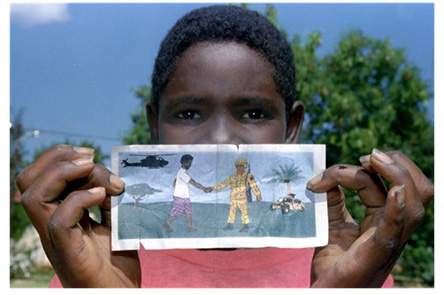
Somali Child, Mogadishu, 1993 - Credit Defense Visual Information Center
The purpose of this paper is to reflect on the events surrounding the U.S. involvement in Somalia 20 years ago and learn from it as U.S. national security professionals ponder intervention in a myriad of similar locations today. It is a chance to review the paradoxical nature of this conflict that fundamentally changed the way the U.S. would view involvement in complex catastrophes, and how the same conflict, seen through the eyes of U.S. adversaries and rivals, provided different set of lessons. The paper will briefly describe the situation in Somalia, outline the history leading up to U.S. involvement in relief operations in the early 1990’s, describe what went right, what went terribly wrong, what the U.S. military learned, and perhaps what it has already forgotten when pondering military intervention in contemporary complex catastrophes.
Prior to 3 Oct, 1993, national security professionals would use the moniker of "Desert One" to describe a kind of military misfortune that degenerated into a major strategic political and diplomatic failure. This phrase originates from the ill-fated 1979 attempt by U.S. military forces to rescue U.S. hostages held in Iran.[2] The force sent to accomplish the mission experienced a major mishap in the desert outside Tehran resulting in multiple U.S. deaths, the destruction of aircraft, and the abandonment and cancellation of the mission.[3] The reverberations from this failure were enormous, with many believing this singular event cost President Jimmy Carter his Presidency. Upon investigation, the causes of the disaster were many, and the aftereffects of this disaster directly lead to many changes in the way the U.S. military trains, organizes, and fights. Some would go as far to say it made Goldwater Nichols Act (The Department of Defense Reorganization Act of 1986) possible.[4] The Act lead to the establishment of the Special Operations Command and many other changes in the way the U.S. employs forces worldwide.
After 3 October 1993, the new parlance for a military disaster of this magnitude with comparable strategic effects was called a "Black Hawk Down" event, describing the lexicon used during the battle for multiple UH-60 helicopters shot down by simple rocket propelled grenades fired from rooftops by Somali irregulars. The term "Black Hawk Down" was introduced to our lexicon through a major series of riveting newspaper articles written by Mark Bowden in the Philadelphia Enquirer which later became a book by that the name Black Hawk Down: A Story of Modern War, which was published in 1999 by the same author.[5] Later, in 2001, a major motion picture directed by Ridley Scott, “Black Hawk Down,” won multiple awards.[6] More recently, during the U.S. raid on Osama Bin Laden, when an American assault helicopter experienced a mishap and crashed, the flashbacks of Mogadishu rapidly resurfaced and the term "Black Hawk Down" was euphemistically used by national security personnel to exclaim what was happening during the early stages of the raid.[7]
Somalia Today....
Somalia today is a failed state by nearly every measure. In fact, it is ranked number one on the Foreign Policy Failed States Index for 2012, and has held the top spot since 2008. The Index is the eighth annual collaboration between Foreign Policy and the Fund for Peace where Somalia has far outdistancing Iraq, Afghanistan, Sudan, and Chad.[8] Government is fractured, economy is in shambles, the infrastructure is in serious decay, and there is no rule of law. It is a hotbed of piracy and illegal trafficking, and even Al Qaeda finds it to be a rough neighborhood to establish a base.[9] The last best hope for Somali ended with the withdrawal of American forces after the Battle of Mogadishu. The next section will describe the events that precipitated this disaster.
Background - A Brief History of U.S. Involvement
Many books, monographs and articles have already been written about this effort, which will not be replicated here, but a brief overview to provide some background and context against the thesis of this piece is in order to understand what occurred and why. Like many military operations that start with one set of intentions and devolve or “creep” into others, the operations in Somalia went through three different and distinct phases over the years 1992 to 1995.
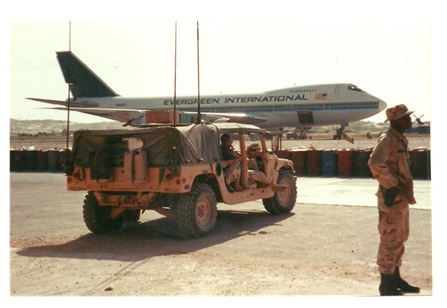
Airlift to Mogadishu, Somalia - Credit Mike Marra, 1993
• An airlift that provided food relief and medical supplies to a multitude of sick, starving people;
• An intervention force that combined continued humanitarian assistance activities with military operations meant to provide better security for relief efforts; and
• A military force that provided the bulk of the combat power for the first “peace enforcement” operation in the history of the United Nations.[10]
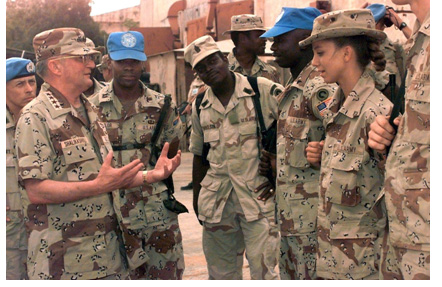
CJCS GEN John Shalikashvili with Army and U.N. Peacekeepers, Somalia, 1992 - Credit Defense Visual Information Center
Along with these phases came different names of the Operation which tried to emphasize different lines of effort.
-- United Nations Operation in Somalia I (UNOSOM I), April-December 1992, which tried to reconcile warring Somali factions but collapsed from bureaucratic infighting and an inability to provide safety and security for relief operations;
-- United Nations Task Force (UNITAV) December 1992 -- April 1993, a multinational force approved by the United Nations and led by the United States, which quickly provided that safety, started a low-key political process, and maintained working relationships with all Somali factions and groups;
-- United Nations Operation in Somalia II (UNOSOM II), May 1993 -- March 1995, the U.N.-led operation that comprised an overreaching, "nation-building" phase (May-October 1993) and a scaled-back, accommodative phase (November 1993 -- March 1995) triggered by the October 3, 1993, firefight in Mogadishu, the departure of the preponderance of U.S. forces in March of 1994, and total withdrawal of UN forces by 1995.
In addition to underlining the complexity of peace operations, these three distinct phases show that, as the level of conflict intensified, some things changed more than others. The specific mission elements examined here also provide a sobering glimpse of the challenges associated with efforts to stabilize a country in chaos, where the effects of by clan warfare and the absence of government were exacerbated by the harsh natural environment. Although drought conditions were partially responsible for this situation, civil war had devastated this already threatened country. Since 1988, this civil war had centered on more than fourteen clans and factions that made up Somali society, all of which fought for control of their own territory.[11]
The Somali culture, which the U.S. barely understood at the time, stressed the idea of “me and my clan against all outsiders,” with alliances between clans being only temporary conveniences. Guns and aggressiveness, including the willingness to accept high casualties, were intrinsic parts of this culture, with women and children considered part of the clan’s order of battle. (This later became painfully evident when Somali irregulars used women and children as “human shields” against Pakistani UN Peacekeepers, resulting in the death of 39 Pakistani Soldiers.)[12] This hostile environment was further fueled by a plentiful supply of individual and heavy weapons left over from Somalia's changing alignments during the Cold War. These weapons found their way from government control to clan armories and individuals.[13]
After the fall of the Siad Barre regime in 1991, the political situation deteriorated, with the clans in the northern part of the country trying to secede. With continuing drought conditions coupled with the already inadequate food situation, clan warfare and banditry gradually spread throughout Somalia. By early l992, these conditions brought about a famine of Biblical proportions: more than 500,000 Somalis had perished of starvation and at least a million more were facing the same fate.[14] “Somalia” had become a pejorative expression for disaster rather than for a geographical location, nation or country. The technologies associated with the information age beamed scenes of starvation and death, orphans clinging to dead parents, and overall chaos around the world daily. The scale of the human suffering in Somalia had, by 1992, captured the attention of the international community and the President of the United States.[15]
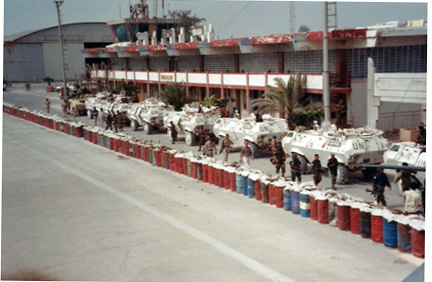
U.N. Convoy, Somalia, 1994 - Credit Mike Marra
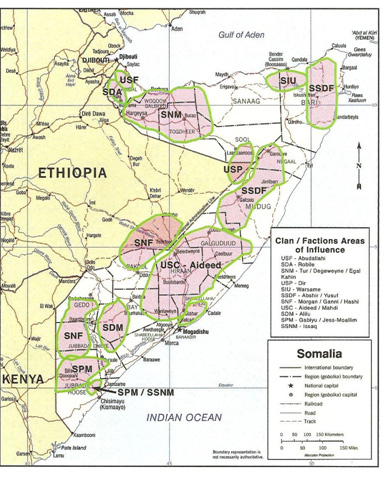
Somali Clan Territories, 1993 - Credit U.S. Defense Mapping Agency
The initial U.N. intervention transformed Somalia from a famine-stricken disaster area where brutal warlords and khat-intoxicated gangs ruled over helpless innocents, into a test-bed for new theories of “world order,” U.N. peacekeeping, and NGO cooperation. Perhaps, ironically, the impressive leadership, coherence, and dramatic success of the U.S.-led UNITAF phase made it look too easy, facilitating the "mission creep" that produced UNOSOM II's vast nation-building mandate. The sheer ease of intervention, combined with the mastery with which it was initially conducted in Washington and in the field, helped produce the slide toward a modern version of trusteeship over an ex-colonial territory, triggering a violent backlash mounted by a powerful Somali faction.[16]
But the goodness was not to last. Within months the situation deteriorated rapidly into ever escalating violence and disorder climaxing in the Battle of Mogadishu on 3 Oct 1993. Now, 20 years later, it is time to reflect on that painful experience, to learn from it and make better informed decisions to address contemporary situations where military intervention remains a strategic option. Each conflict through history is different, and it is very easy to misapply lessons learned from event to event. Still, there are valuable lessons to be learned which could illuminate some of the unintended consequences of future interventions.
What went right?
The intervention saved lives and helped avoid continuing famine. Tons of food and medical supplies arrived from around the globe, and human capital was infused into a dying nation not a moment too soon, resulting in perhaps hundreds of thousands of lives saved. The specter of mass starvation was checked through U.S. military logistics capability honed in the Gulf War. The combined logistical genius of the U.S. and coalition forces deftly used Air, Land and Seapower to synchronize and harmonize aid from all over the world. Although there were only a few viable air and sea ports and unimproved roads to set up key distribution points, the coalition was able to rapidly deliver aid to the people who needed it desperately. This was a marvel akin to the Berlin Airlift in 1947, where combined military forces saved Berlin through the air with enormous political implications. While the political stakes were not analogous to the situation in Somalia, the many lives saved by effective military capability were obvious. How large a tragedy the intervention prevented is impossible to know, but, judging by the Somali death toll of 1992, one could reasonably estimate that the intervention saved upwards of 500,000 Somali lives. The intervention in Somalia was not a failure as measured by the standards first set by President Bush in avoiding a lethal famine.
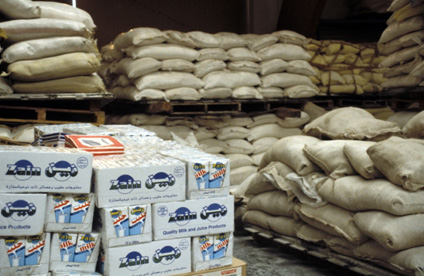
Food Arriving the Mogadishu Airport, 1993 - Credit Defense Visual Information Center
The United States effectively shaped a unified effort with a willing coalition. Fresh off the stunning coalition victory in the Gulf War, the United States parlayed that political capital into a true coalition of capable nations who delivered aid and provided security under the flag of the United Nations. Unlike the formation of most coalitions, this one was comparatively easy to form based on the positive relations developed during 1990 - 91 Operation Desert Storm. The U.S. had the prestige and gravitas as a world leader in a "New World Order" and Somalia would be one of the first test-cases. There have been approximately 60 officially sanctioned United Nations "peacekeeping" operations since 1948, illustrating how difficult this is to achieve.[17] Operation Restore Hope was an act of human solidarity without regard to race, religion, or region. That is why the Congress and the American people supported it -- just as they supported the 1991 effort to protect Iraqi Kurds and many other such operations where there was no direct correlation to core national interests.
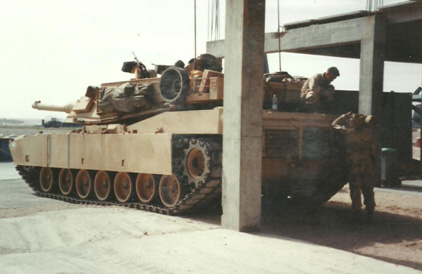
U.S. Army M1A1 Tank, Somalia, 1994 - Credit Mike Marra
The United States military worked well with Non-Governmental Organizations vis'-a-vis cooperation, information, security and the building of genuine trust. While not initially the case due to the strong emphasis on combat operations in Desert Storm, coalition forces rapidly learned to cooperate with many NGO's and learned where the humanitarian needs were the most compelling rather than simply taking the word of pseudo - officials from the failed Somali government. This resulted in more effective and efficient aid distribution. Similarly, by providing protection and security, the NGO's were able to do much more good than ever before when various rival groups would "use" their services as bargaining-chits for political power and influence in given regions.[18] These NGO's firmly believed local Somalis had to be part of the solution and be seen as "in the lead" in rebuilding their nation - a critical optic for a nation in need of a unifying belief that they could help themselves. The Somali people are proud, strong and generally self-reliant. They did not wish to become a "donor state" and by leveraging their local leadership as opposed to national leadership or clan leadership, they realized modest successes. This success in Somalia was to be replicated many times over following this operation.
While the Somalia intervention was not all bad news, national security professionals must examine the negative aspects of the operation if they are to critically think through what happened to avoid future pitfalls in responding to complex catastrophes in the future. While many other papers outline the operational and tactical details, the following strategic shortfalls are not so obvious.
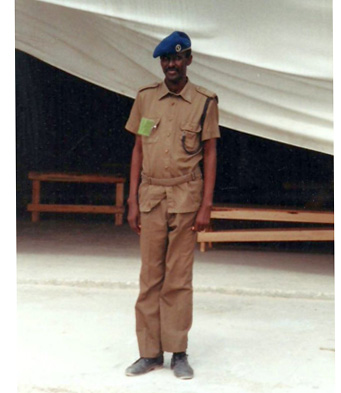
Somali policeman, Mogadishu, Somalia, 1994 - Credit Mike Marra
What went wrong?
Faulty Assumptions. The U.S. deployed believing this was a peacekeeping mission, but in fact, there really was no peace to keep. It has to be imposed on the warring factions. Dag Hammarskjöld, Former UN Secretary-General once said, "Peacekeeping is not a job for soldiers, but only soldiers can do it". While coalition presence had an immediate positive effect on the entire situation, this respect and admiration was not to last long. .U.S. and other coalition forces continued to be challenged to the point of outright confrontation often ending in violence and bloodshed, thereby escalating hostility amongst the populace. The American belief was that if it is there to help, then surely the population would be happy to see the U.S. and cooperate. This was not an accurate or realistic assessment of the situation, as many warlords were already clashing. The famine was simply just another context to operate within, and for some factions, conflict offered opportunities for competitive advantages for political power. When the U.S. arrived and started re-distributing food, the new “coin of the realm,” it changed many competitive advantages and resulted in anger, distrust, and acrimony within the society the coalition was trying to help.
Unrealistic Time Horizons. The U.S. and the UN had a very optimistic idea of what it would take to get Somalia back to a place where it could function without being on international life-support. The pace of such an operation must match that of the culture or it is hampered by constant friction and frustration – and this is where the time horizons diverged. Coalition forces wanted change and reformation in Somalia much more than did the Somali's, which created one of the core issues of conflict and tension. While the U.S. saw a hierarchical system of governance which drove subsequent distribution of aid assets, the existing system was actually tribal and worked on a completely different system of “…who got what - where, where and how.” U.S. domestic timelines that revolved around elections and other political agendas should have been set aside, but the political aspects of any conflict nearly always rule, and Somalia in 1993 was no exception.
Strategy/Resources Mismatch. In reflecting on the mission to Somalia, General Freeman, who had been involved extensively in U.S. Central Command's planning for Operation Restore Hope, stressed "interests, ends, means, all three have to be in balance" in any future intervention of this type. The U.S. never balanced resources to execute the strategy in Somalia. Because no feasible end-state was ever articulated by the U.S., the efforts were not synchronized toward any clear goal, but rather a nebulous and ambiguous state where the situation was "normalized." In a nation where there is no "normal" but varying levels of chaos, the goal moved and shifted until the coalition could achieve a minimum acceptable level of stability. While the UN Security Council was interested in helping Somalia climb out of its abyss, it never gave commensurate resources to UNOSOM II to accomplish the mission. "This was the huge frustration we had out in the field," claimed one participant. "‘Give us the tools,' we cried. And it wasn't that I wasn't asking for them constantly." With regard to military input at the national level, General Montgomery, the commander of U.S. forces added: "I think it is the responsibility of senior military people to tell the policy level what it is they need in terms of military means to do the job and not to try and pre-guess what will fly politically or not. You need to say, ’Here's what we need to do the job.’ And let them say yes or no before you start deciding what might fly politically.”[19]
Knowing what went right and wrong in the U.S. intervention in Somalia is important. The more difficult and subjective analysis must take place to enable the artful application of lessons learned for contemporary situations where a myriad of issues will be different, but the core issue of addressing a complex catastrophe at the strategic level will remain constant.
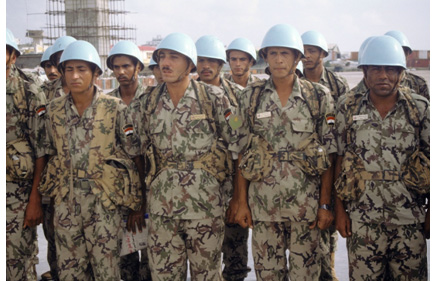
Egyptian Peacekeepers in Somalia, 1992 - Credit Defense Visual Information Center
Lessons Learned
Environmental framing can never stop. Whenever the U.S. or a coalition deploys forces into a third country, the environment changes, driving new assessments and iterative approaches to framing the environment, defining the problem, and devising various approaches or strategic options. This lesson is now being addressed by U.S. military doctrine and in professional military education at all levels.
Security works hand in hand with development and diplomacy, but has to come first and foremost in contested and austere environments. This security, defined by a belief that one could exist in the society without fear of personal harm, or fear of being relived of all possessions is essential and imperative. Security was essential in order to control the mostly ungoverned area long enough to establish some order which in turn enables development of stable institutions of governance and infrastructure. At a minimum, the objective has to be the establishment of a responsible state entity that can ensure the well-being and safety of its people.
Military Interventions Change the Existing Balance of Power. This lesson of Somalia may be the most humbling to those countries capable of providing humanitarian assistance like the United States. Despite good intentions, the environment will change with the introduction of military power. Just as humanitarian relief may temporarily disrupt a local economy, changing the stakes of conflict and even, perversely, fueling it; military intervention may alter the regional and local balance of power. The effort in Somalia was a painful example of this axiom. The UN coalition’s presence temporarily strengthened Somalia's vestigial civil society and challenged the warlords' political monopoly. By freezing in place the factional strife, it also checked the stronger factions and protected the weaker ones. Thus, the die was cast for a showdown on 3 October 1993 in the streets of Mogadishu. The strategist looking at the next intervention must have a viable follow-on to military intervention which will lead to a peaceful transition to civil authority, lest they be deployed there into perpetuity.
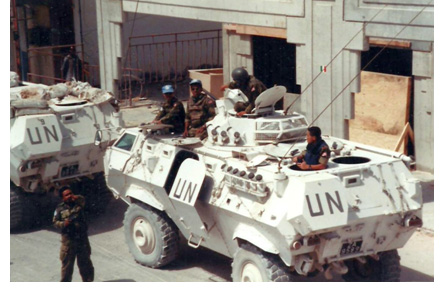
U.N. Convoy About to Depart Mogadishu Airport, 1994 - Credit Mike Marra
The United States was not the only nation to learn from Somalia. Many adversaries and potential challengers saw the operation as exposing some vulnerabilities of the “..World’s only superpower,” as America was labeled in the 1990’s. Several of these perceptions still exist as evident by U.S. enemies’ strategies and tactics against throughout the conflicts in Iraq, Afghanistan and elsewhere.
What U.S. Adversaries Perceived
The world saw the U.S. rapidly withdraw from Somalia after the Battle of Mogadishu based on a high casualty count. While there was a "plus up" of forces in the region directly afterward, including more Air, Land, and Seapower assets, the die had been cast for a complete withdrawal by March of 1994 Statements made by President William J. Clinton after the battle tried to placate American dismay over the sordid and tragic images and narrative of the Somalia mission gone bad. Potential U.S. adversaries left with the perceptions that America would fight for many things, but would not die for seemingly peripheral causes, and that inflicting casualties and making those losses public was a strategy to erode U.S. will leading to U.S. disengagement.
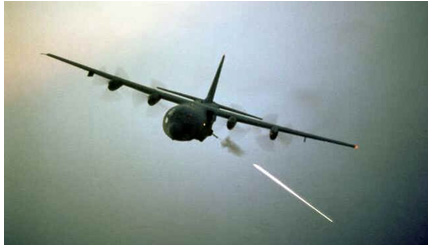
AC-130H, Deployed to Somalia Multiple Times to Provide Close Air Support/Troops in Contact Missions
Adversaries saw the U.N. as a viable place to dialog and joust diplomatically, but as a weak and ineffective organization for running military operations. The U.N. military effort was often fragmented on policies, rules of engagement, doctrine, equipment and overall capability. While this is not different from other U.N. actions, Somalia perhaps reached a new low in cooperation. After Somalia, opponents of the U.N. concepts of statehood and rule of law were emboldened to do as they pleased, as the U.S. saw in the Balkans in Srcebenicia. There, U.N. forces were disarmed without a struggle, and genocidal atrocities continued unabated. These actions clearly underscored the lack of fear and respect for these peacekeeping forces.
There is no such thing as a purely humanitarian operation when the military is involved. The operation in Somalia calls attention to the question of how humanitarian intervention can evolve into a long-term stability as opposed to simply addressing symptoms of a problem. The Bush and Clinton administrations insisted on a quick handoff to the U.N. It is hard to escape the conclusion that an appeal for outside force must be accompanied by a political strategy for the nation and for the region before committing military forces. As Chester Crocker put it, “..unleashing the dogs of war while healing the wounds of war.”[20]
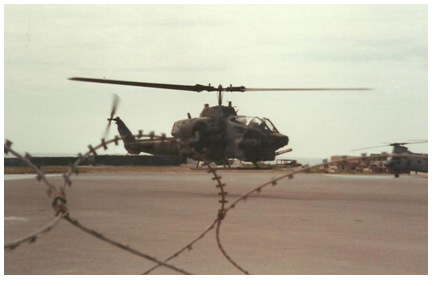
USMC Cobra Attack Helicopter, Mogadishu Airport, 1994 - Credit Mike Marra
After Somalia, the U.S. had another opportunity to act in Rwanda in 1994, but decided not to deploy forces, due in large part from the ghosts of Mogadishu. Those seeking power through force in countries around the world were embolden to act, knowing that the absence of the bi-polar balance left a security vacuum in many regions that would go unfilled with the lack of Cold-War competition for access and influence.
Today the U.S. is poised to act to similar crises around the globe. The clarion-call for intervention comes in many forms and in many places too numerous to list here, but there is continuous pressure on any U.S. President to act under a new concept called Responsibility to Protect, or "R2P" for short.[21] Secretary of State Madeline Albright championed this concept. But, before the U.S. heeds her advice and others like Senator John McCain, who has vociferously advocated “doing something” in Syria, the U.S. leadership should consider these seemingly forgotten lessons from Somalia.
Lessons Forgotten
Strategy formulation. As a nation, no operational or tactical events are powerful enough to overcome a lack of comprehensive strategy for a situation, nation, or region. As the U.S. deployed into Somalia in 1992, not enough strategists put thought into "...and then what?" There was little talk of the Horn of Africa as a whole, but only of ameliorating the famine in Somalia itself and making those images of starvation go away. This lack of a regional approach is sometimes seen today, as in Syria, Egypt, Afghanistan, and in other areas where "fixing" a singular nation is clearly not the total answer. An end-state with a realistic transition into the future must be designed from the start.
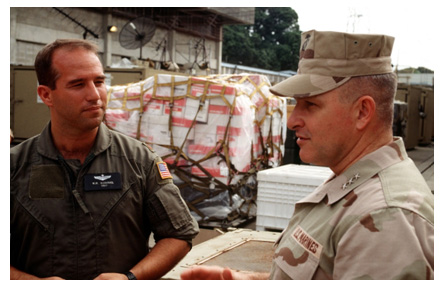
LtGen Anthony Zinni, USMC with Maj Michael McDaniel, USAF, Somalia, 1993 - Credit Defense Visual Information Center
The value and utility of Landpower. If the U.S. really wants to affect what is happening on the ground in any nation during a complex catastrophe, it will take "boots on the ground." This is the one thing most politicians seek to avoid when edging near military action and seeking popular approval. There are times when ground forces are not appropriate, but immediately ruling them out far in advance of any intervention is generally ill-advised. While the U.S. has developed strong anti-bodies to this type commitment over the last decade, it simply can't be ruled out from the start as a strategic option lest we severely limit our military options and provide any adversary with one less set of challenges to confront.
Shaping vs. reacting. As the U.S. has learned, re-learned and forgotten many times, it is much more costly to do consequence management than it is to do prevention or pre-emption in these predictable catastrophe situations. Waiting until a nation utterly fails and falls into chaos before acting is far more difficult, dangerous. and costly. The geographic combatant commands and their functional components know and understand this, and work closely with Dept of State and U.S.AID experts to preclude these from becoming far worse than if left unattended.
The 3D approach. The "military-only solution" is not and should not be the first and only tool the U.S. leadership reaches for in a catastrophe. Any strategic option the U.S. considers should be a blend of "diplomacy, development and defense," as complex catastrophes are rarely solved by just one element of power.
Conclusion and a Warning for the Future of Intervention
President Kennedy once commented, "Success has a thousand fathers, but failure is the orphan child."[22] No military organization celebrates or enjoys recalling catastrophe or operational failure. For U.S. military forces, Somalia was both humiliating and costly. But, failures are often the situations where a nation or organization can learn the very most, as the cost in blood and treasure is both deep and impressionable.
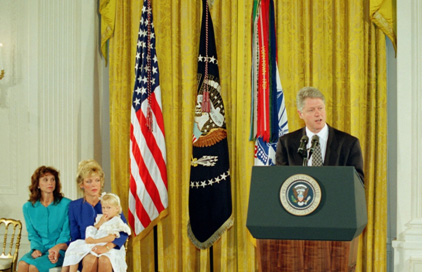
President Clinton Awards Medals of Honor to the Wives of U.S. Army SFC Shughart and MSGT Gordon - Credit Defense Visual Information Center
Lieutenant General Thomas M. Montgomery, U.S. Army, who served concurrently as Commander of U.S. Forces in Somalia and Deputy Commander of United Nations Forces in Somalia (UNOSOM II) from March 9, 1993 to March 28, 1994, and then as Commander of the Joint Task Force in Somalia during his final four months there captured this best: In the United States, the aftermath of the operational failures in Somalia, has haunted U.S. foreign policy to this day. And if you're reading the press on Afghanistan and Iraq, the ghost of Mogadishu on 3 October 1993 looms very large even today. It certainly looms large in the minds of many of our soldiers in the field. The fact that potential lessons from Somalia have not been shared widely was an explicit concern for many who realized that complex contingencies and failed states have great salience today. Having lived through the dark and brutal night depicted in Black Hawk Down, the veterans of Somalia wanted their experiences disseminated to avoid the need for young Americans in the future to relearn them the hard way—on the battlefield.[23]
End Notes
[1] Richard W. Stewart, PhD, "The US Army in Somalia," The Army Center for Military History, December 2002, Printed by AUSA, p. 19.
[4] Goldwater-Nichols Act of 1986, US Code, Cornell University Law School web page. http://www.law.cornell.edu/uscode/text.
[5] Mark Bowden, Black Hawk Down: A Story of Modern War. Atlantic Monthly Press. Berkeley, California (USA). (March 1999). ISBN 0-87113-738-0.
[6] Ridley Scott, Black Hawk Down, the film, Columbia Pictures, (18 Jan 2002), 144 minutes, based on Black Hawk Down: A Story of Modern War, by Mark Bowden (March 1999).
[7] Mark Bowden, "The Finish: the Killing of Osama Bin Laden," 19 Oct 2012 New York Times, Sunday Book Review.
[8] Failed State Index for 2012, Foreign Policy online, Sunday, 1 Sep 2013, page 1. http://www.foreignpolicy.com/failed_states_index_2012_interactive
[9] Hassan M. Abukar, "The Letters, How Al Queda Failed in Mali and Somalia," April 18, 2013, Copyright http://www.wardheernews.com/the-letters-how-al-qaeda-failed-in-mali-and-somalia/© 2013 Wardheer News, All rights reserved.
[10] Kenneth Allard, PhD, COL, USA Somalia, Lessons Learned, CCRP Publication Series Univ Pr of the Pacific (April 2002), Introduction, page xvii.
[11] Chester A. Crocker, "Ambush in Mogadishu, Not Everything Went Wrong," Foreign Affairs, May-June 1995, Vol. 74, number 3, 1995, Copyright 1995 by the Council on Foreign Relations, 1995, page 1. http://www.pbs.org/wgbh/pages/frontline/shows/ambush/readings/lessons.html
[12] Pakistan Army Report, report of 39 fatalities during UNOSOM I and II, 1993 to 1995, Pakistan Army Web Portal, 2009-2013 http://www.pakistanarmy.gov.pk/AWPReview/TextContent.aspx?pId=57
[14] Col Dennis P. Mroczkowski , USMC, Restoring Hope - in Somalia with the Unified Task Force, History Division, USMC, Wash, DC, 2005, page 7-8.
[16] Walter S. Poole, The Effort to Save Somalia, Aug 1992 - March 1994, Joint History Office, Office of the Joint Chiefs of Staff, Wash, DC Aug 2005, pages 23-26.
[17] United Nations Official Web Site - list of Peacekeeping Operations since 1948; http://www.un.org/en/ and http://www.un.org/en/peacekeeping/documents/operationslist.pdf
[19] Lieutenant Colonel Frank G. Hoffman, U.S. Marine Corps Reserve (Retired), "One Decade Later -- Debacle in Somalia," Proceedings, January 2004, pages 1-3, http://www.military.com/Content/MoreContent1?file=NI_Somalia_0104
[20] Crocker, Foreign Affairs, page 3. http://www.pbs.org/wgbh/pages/frontline/shows/ambush/readings/lessons.html
[21] The Responsibility to Protect; Report of the International Commission on Intervention and State Sovereignty, Published by the International Development Research Centre, PO Box 8500, Ottawa, ON, Canada K1G 3H9, http://www.idrc.ca. © HER MAJESTY THE QUEEN IN RIGHT OF CANADA 2001, as represented by the Minister of Foreign Affairs, National Library of Canada, International Commission on Intervention and State Sovereignty
[22] J. F. Kennedy, There's an old saying that victory has 100 fathers and defeat is an orphan.
[1961 J. F. Kennedy News Conference 21 Apr. in Public Papers of Presidents of U.S. (1962) 312]; http://www.answers.com/topic/success-has-many-fathers-while-failure-is-an-orphan#ixzz2dm9bCofa
